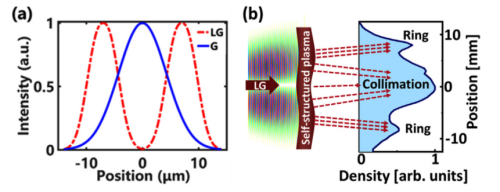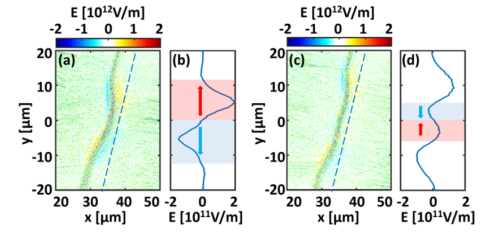The researchers in the State Key Laboratory of High-Field Laser Physics at the Shanghai Institute of Optics and Fine Mechanics (SIOM), Chinese Academy of Sciences (CAS) have made progress in high-efficiency beam proton acceleration by ultra-intense vortex laser-driven plasma prisms. The corresponding paper of Collimated particle acceleration by vortex laser-induced self-structured “plasma lens” is published in Applied Physics Letters recently on November 21, 2022.
Obtaining proton beams with small divergence angle and high collimation has always been a difficult problem in the application of laser-driven particle acceleration. In order to solve this problem, scientists have proposed to use structural targets, cascade acceleration, magnetic quadrupole iron and other schemes to modulate the high-energy ions.
However, these methods provide a kind of "electric prism" or "magnetic prism" horizontally to focus high-energy ion beams. The structured targets are complex and expensive; the accurate space-time synchronization for the multi-beam lasers is critically required, which is difficult to achieve in experiments. So, the high-repetition-rate collimated proton accelerations for innovative applications in upcoming high-repetition-rate petawatt laser systems are needed. It is urgent to find a simple scheme that can reduce experimental requirements to achieve it.
Fortunately, ultra-intense Laguerre-Gauss (LG) lasers provide us an efficient way to obtain a high-repetition proton source. Studies show that the concave plasma expansion can be "self-precisely" formed by using the pre-pulse and main pulse of a single ring LG laser. The corresponding divergence angle of the proton beam is ~2.7°, which is driven by the concave sheath field at the target back. This result is only 1/10 of the acceleration of the proton beam driven by the traditional Gaussian laser.
At the same time, the maximum cutoff energy of the proton beam can be increased by ~50%. This mechanism provides a feasible and effective method for the wide application of high-repetition-rate proton source on the high-repetition-rate PW laser facilities.
This work is based on the previous theoretical paper and experimental paper, and can benefit for general applications.

FIG. 1. (a) Intensity profiles of LG (dotted dashed line) and Gaussian (solid line) laser. (b) Collimation acceleration driven by the LG laser. (Image by SIOM)

FIG. 2. Transverse distributions of the electric fields at t~100TL for (a) Gaussian laser and (c) LG laser. Electric field distributions along the target parallel direction [dashed lines in (a) and (c)] for (b) Gaussian laser and (d) LG laser. (Image by SIOM)
Article Website:
https://doi.org/10.1063/5.0121973
Contact:
WU Xiufeng
General Administrative Office
Shanghai Institute of Optics and Fine Mechanics, CAS
Email: xfwu@siom.ac.cn
Web: http://english.siom.cas.cn/